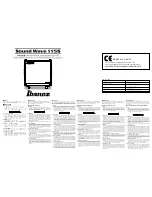
8
Connection Types
The Sherbourn PT-7020A has four types of video
connections on board (3 Analog and 1 Digital) and 4 types
of audio connections on board HDMI, RCA, OPTICAL
and BALANCED (Subwoofer Only).
Video Connections
Composite Video
Analog composite video signals are connected between
products with a single 75-ohm coax cable with Yellow RCA
connectors on each end. Composite video inputs or outputs
are present on almost all types of consumer grade video
equipment.
Analog Picture Quality: Poor. This is the lowest quality
discrete cable for a video source and is not recommended.
S-Video
Most midrange and premium video equipment provide the
option of using S-video connections.
The S-video (or Y/C) cable is terminated at each end with
a four-pin DIN connector. Although it may appear to be a
single cable, internally it has two 75-ohm coax or twisted
pair cables to carry the separate Y (luminance) and C
(chrominance) signals. This is also an analog video signal.
Analog Picture Quality: Fair. The s-video cable is an
improvement over a Composite cable but still not
recommended.
Component Video
Component cables look just like composite cables. The
difference is that, where a composite cable carries the entire
video signal on a single cable, component cables split the
signal to three cables.
The signal itself is referred to as either, Y, Cr, Cb or Y, Pb,
Pr. Manufacturers make connecting these cables easy by
color coordinating them. The tips of the cables and jacks
will be red, green and blue.
A good rule of thumb is that, if the connections are RCA
type, it is usually a component cable. Most high-end DVD
players and HDTV tuners will have analog component
video connections.
Analog Picture Quality: Good. Gives a superior image over
Composite or S-Video connections.
HDMI
High-Definition Multimedia Interface (HDMI) is an
uncompressed, all-digital audio/video interface in a single
cable. HDMI supports standard, enhanced, or high-
definition video, plus multi-channel digital audio on a
single cable. It transmits all ATSC HDTV standards and
supports 8-channel, 192kHz uncompressed digital audio
and all currently available compressed and uncompressed
formats (such as Dolby Digital, Dolby True HD, Digital
Plus, PLIIx and DTS-HD Master Audio, DTS-HD High
Resolution Audio, DTS Digital Surround ES - Neo:6 - 92/
24).
Only HDMI video inputs and outputs are supported
onboard the Sherbourn PT-7020A chassis. This offers full
compatibility with 5 HDMI input devices and one HDMI
output to an HDMI display device. The HDMI section of
the PT-7020A supports 480p 60Hz, 576p 50Hz, 720p 50Hz,
720p 60Hz, 1080i 50Hz, 1080i 60Hz, 1080p 50Hz, and
1080p 60Hz resolutions. The most common resolutions
for the United States are 480, 720 and 1080 at 60Hz. (50Hz
resolutions are primarily used outside of the United States.
The PT-7020A is fully PAL compliant.
Note: 1080p24 from the input source will get routed
through the PT-7020A as 1080p24 but 1080p24 is not
selectable for scaling.
HDMI offers the Best in video resolution. Sherbourn
recommends using HDMI as the preferred connection.
Audio Connections
There are two ways to transmit audio signals available with
the PT-7020A. Digital and Analog. The Analog Signal is
an electrical waveform representation of sound and it
requires one cable for each channel. The Digital Signal
uses a sequence of numbers for sound representation and
requires only one cable for all channels.
All audio inputs on the PT-7020A can be either Analog or
Digital. Any audio input can be set to:
DSP (Digital Signal Processing) for surround modes, bass
management, bass/treble treble control and the unique
multi-channel room correction and automatic loudspeaker
setup.
DIRECT, which bypasses all digital stages.
You can connect your source components using an HDMI
connector, RCA connector, OPTICAL connector and
BALANCED (subwoofer only).
Summary of Contents for PT-7020A
Page 39: ......









































